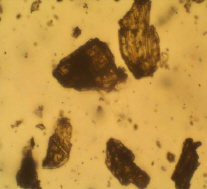About the chemical structure:
| Chemical name: | Arsenic sulfide |
| Formula: | As2S3 |
| Crystal system: | Monoclinic - Prismatic (at Mineralogy Database) |
| Refractive index: | Biaxial: alpha = 2.4, beta = 2.81, gamma = 3.02 |
Color:
| Color Index (C.I.) | PY 39 |
How can you identify Orpiment?
Imaging:
UVF: no
IRFC: pale white
OM: large particles may appear to have a waxy, glazed appearance. Look for characteristic orange-red realgar particles which are often present. Crystalline yellow cleavage fragments. Occasionally a fibrous structure may be seen. Particles are usually between 1-30μm in size.

Microscopic appearance at x500 mag
Analytics:
It's identified by means of Raman. Confirmed by microchemical tests for As and H2S evolution.
Raman spectra: University College London;
Usage and handling:
| Permanence: | Toxicity: |
|---|---|
Lightfas: good. Degradation process: stable to light and air, it is incompatible with lead and copper pigments like lead white, lead-tin yellow, and verdigris, and will darken them. |
very toxic. The toxicity of arsenic sulfide pigments has been known for years. Extreme caution must be used when handling the dry orpiment pigment, as well as in any soluble form, to avoid inhaling the dust or ingesting it. MSDS: Natural pigments |
Literature:
Wallert, A. Orpiment und Realgar, Maltechnik-Restauro, 90, 1984, s. 45
Artists’ Pigments. A Handbook of Their History and Characteristics, Vol. 3: E.W. Fitzhugh (Ed) Oxford University Press 1997, p. 47-79
Lucia Burgio and Robin J. H. Clark, Comparative pigment analysis of six modern Egyptian papyri and an authentic one of the 13th century BC by Raman microscopy and other techniques, J. Raman Spectrosc. 31, 395–401 (2000)
(intro) - Cadmium yellow/red - Chrome yellow - Cobalt yellow - Indian yellow - Lead-tin yellow - Lemon yellow - Naples yellow - Orpiment - Yellow ochre

